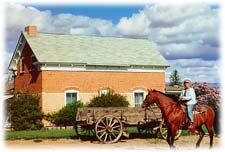|
In 1866, while cavalry men were in pursuit of Indians during the Black Hawk war, they took note of this valley. In the summer of 1875, a company of men from Panguitch, Utah, explored this area, naming it "Potato Valley."
The first settlers arrived in the spring of 1876, surveying and staking off 36 five-acre blocks, separated by wide streets. The main road ran north and south for six blocks. Center Street ran east and west for six blocks. Years later, these were reversed when came in east and west.
Following the "Zion plat" plan, the blocks were sectioned into four 1 1/4 acre lots. Each block and lot were numbered. These numbers were written on pieces of paper and placed in a hat. The head of each family drew a number providing an "inheritance." When Utah applied for statehood, all settlers paid for the lands they had received.

Thanks to Sheila Wooley for providing the historical information.
On July 4, 1876, because no American flag was available, the small group of pioneers raised a striped Navajo blanket, amid much shouting and fanfare. During this celebration, they officially named the town after Fray Silvestre Velez De Escalante, a Spanish priest who accompanied Fray Fransisco Atanasia Dominguez, the leader of the Dominguez - Escalante expedition that came through southwestern Utah in 1776, searching for a passable trail to Los Angeles, California.
The Mormons who came here were not sent as colonists by Brigham Young. They came seeking a mild climate, and were successful in growing fruits, vegetables, black walnuts, and even mulberry for silk worms. Their first homes were dugouts and their wagons. For protection from the elements, log houses were the natural choice because timber was plentiful.
Every lot had space for a house (usually placed on a corner) a barn, and a garden. Each family also received a twenty-acre plot to farm outside of town. The cattle were driven out to graze on these lands during the day and brought home for milking at night. Thus the Mormons kept in close communication with their neighbors unlike farmers in other parts of the country who lived outside town.
The economy around the turn of the century was based on farming and livestock, and as their finances improved, the settlers could afford better housing. Three kilns were built (near the present day race track), and bricks fired there were used to construct homes. Prior to this time they had only sun baked adobe bricks. These tended to "melt" when exposed to water over a period of time. Sometimes an early log home was dragged somewhere else and a brick home was erected in its place. Other times the log structure was incorporated into the expansion effort.
Most of Escalante's brick homes were built prior to 1910. The foundations were either sandstone blocks, or volcanic rocks in concrete. Each room had an outside door. Walls were four bricks thick. Barns were also moved and were placed on rocks to keep the wood from rotting. Most people had both a barn and a granary with a root cellar underneath it. All the lots were enclosed with board fences to keep stray animals out of the gardens.
|
Some fences still stand today. Water initially was transported to each individual home by a barrel placed on a wooden sled called a "lizard". The barrel was filled with water from the Escalante River and later from the "Big Ditch" which held irrigation water. Some residents dug wells. Eventually irrigation ditches were dug along each street, and families could get the water directly out front. Animals were kept corralled each morning until after the clean water had been brought in.
Later, underground cisterns were used to store a year-round water supply from the irrigation ditches. It was 1937 when all the families finally had culinary water piped into their homes. For many years black locust trees lined all the streets, thriving on the irrigation water. When the ditches were filled in 1982, following the installation of pressurized irrigation water, most of the trees died and had to be removed.
In 1908, telephone lines were strung from Teasdale to Escalante, down Pine Creek. as a Forest Service project so fires could be reported. In 1910, the lines went to Boulder along the "Mail Trail," and later up Main Canyon and on to Panguitch. Leander Shurtz, a young blind boy manned the switchboard until 1945, recognizing every voice and which "Aunt Mary" they wanted to talk to. There were about 1200 people in town around that time, yet he continued to recognize people even when they had gone away and come back years later.
The Escalante Light and Power Co-op was formed by the Shurtz family in 1919. They ran the power to a grist mill they had built at the spring northeast of town. Later, generators were brought over from Parowan, and by 1922, poles had been erected down the main street, lamps were mounted, and power was furnished only in the evenings. The cost for power in those days was $2.50 per month and wages were a dollar a day, so few people could afford the luxury. Garkane Power took over service in the late 1930s.
>Facts and Figures|>Fall|>Heritage|
>Seasons|>Spring|>Summer|>Winter|
|





